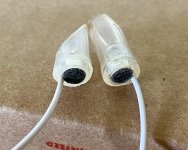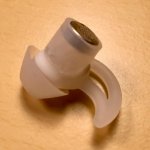So i received a free set of headphones with a parcel today. On the back I noticed its frequency response spec on the back (20-10kHz) So I thought i'd try to see if i could test and confirm those specs, which i could. Though I was a little bit surprised with what I found.
Maxell MHP-EP02 (in ear) (10kHz spec, 13 to 10kHz measured)
Sennheiser HD429 (over ear) (22kHz spec, 9kHz measured)
Sennheiser CX 3.00 (in ear) (21kHz spec, 16kHz measured)
Thoughts?
- First, it turned out that I had the wrong settings on my computer which limited the output to 23kHz, so that was rectified.
- It turns out that even if its frequency response was only up to 10kHz, I could still measure output up to 40kHz.
- Understanding that the 10kHz earphone spec is where output volume begins to drops, not where it fades to zero. (Measured as 13.3kHz first try and dropped to 10kHz on subsequent tests)
- After testing the over ear sennheisers a few more times, it seems i'm getting drop outs. I wonder if doing these tests is damaging my DAC, headphones and/or mic....?
- So it may still be possible that I haven't lost my precious young high frequency hearing just yet? And perhaps maybe it's just the limit of my old headphones or is the limit of my old DAC?
Maxell MHP-EP02 (in ear) (10kHz spec, 13 to 10kHz measured)
Sennheiser HD429 (over ear) (22kHz spec, 9kHz measured)
Sennheiser CX 3.00 (in ear) (21kHz spec, 16kHz measured)
Thoughts?
Attachments
-
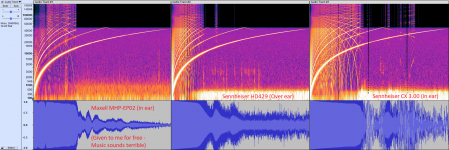 3x headphones test.png423.6 KB · Views: 169
3x headphones test.png423.6 KB · Views: 169 -
 3x headphones retest 2.png533.5 KB · Views: 155
3x headphones retest 2.png533.5 KB · Views: 155 -
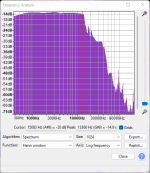 Maxell MHP-EP02 (in ear) Freqency Response 13kHz.png10.4 KB · Views: 132
Maxell MHP-EP02 (in ear) Freqency Response 13kHz.png10.4 KB · Views: 132 -
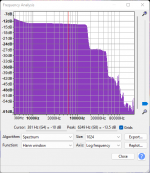 Sennheiser CX 3.00 (in ear) Freqency Response 16kHz.png10.1 KB · Views: 143
Sennheiser CX 3.00 (in ear) Freqency Response 16kHz.png10.1 KB · Views: 143 -
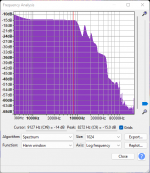 Sennheiser HD429 (Over ear) Freqency Response 9kHz.png10.4 KB · Views: 150
Sennheiser HD429 (Over ear) Freqency Response 9kHz.png10.4 KB · Views: 150
The physical setup is pretty simple. I just attached a microphone against the headphone driver (in such a way that it's direct and secure, sometimes using sticky tape when needed). I tried to make sure that the cables were separated to avoid any potential cross-talk.I've no idea how to properly test headphone FR. Also no idea how you ran the tests above - physical setup - so commenting is difficult.
I then used a high quality sine wave sweep (1Hz to 96kHz) downloaded from here: https://www.audiocheck.net/testtones_highdefinitionaudio.php
I then used Audacity to record the headphone output from the microphone. From there you can view the spectrum information.
Oh I also forgot to mention that my DAC/ADC is a Creative Labs SB1240 and the setup microphone came with my Onkyo AV receiver and is branded Audyssey.
I noticed that too... weird isn't it... I have no idea why either. I was thinking it's either the limitation of the driver, or perhaps there is a high pass filter somewhere. I know in other cases, it could be from a cross over between 2 devices like a main speaker and a tweeter... But I doubt there's more than one driver in my earphone as it's tiny. Maybe it could be coil whine from the driver itself? But I'm just guessing.There is a strange, staircase-like shape in the frequency responses, particularly in the CX 3.00 response. Does anyone understand why?
Also i have a sneaking suspicion that maybe the super long microphone cable might be to blame... I don't even think I could get a clean signal with using just a direct male to male 3.5mm stereo cable... I'm no expert but to me it kind of looks like impedance reflections? I also suspect they're picking up noise like a radio antena... but I'm just making it up as I go lol...
About the middle of this page is a section on measuring earbuds and headphones:
http://www.johncon.com/john/wm61a/
Or maybe you can use one side of the pair of transducers as a mic:
http://www.johncon.com/john/headphone-reciprocity/
It might be better to remove some variables and drive the headphones with pink noise from a test CD (or file), then view the response with spectrum analyzer program.
Here's a free test CD with pink noise and other test signals.
https://www.focal.com/en/focal-teach/cd-focal-tools
I downloaded test CDs from this place in the past; my browser thinks it isn't safe, though, so I've linked to the archived version.
https://web.archive.org/web/20190302012737/http://websound.ru/test_samples_e.htm
http://www.johncon.com/john/wm61a/
Or maybe you can use one side of the pair of transducers as a mic:
http://www.johncon.com/john/headphone-reciprocity/
It might be better to remove some variables and drive the headphones with pink noise from a test CD (or file), then view the response with spectrum analyzer program.
Here's a free test CD with pink noise and other test signals.
https://www.focal.com/en/focal-teach/cd-focal-tools
I downloaded test CDs from this place in the past; my browser thinks it isn't safe, though, so I've linked to the archived version.
https://web.archive.org/web/20190302012737/http://websound.ru/test_samples_e.htm
This site has more 'phone info than a sane person could probably stand- https://www.superbestaudiofriends.org/index.php
That looks like a fun and affordable project. Cheers.About the middle of this page is a section on measuring earbuds and headphones:
http://www.johncon.com/john/wm61a/
Or maybe you can use one side of the pair of transducers as a mic:
http://www.johncon.com/john/headphone-reciprocity/
After looking through my jacar catalogue, i guess it's more than possible that my 'fancy' Audyssey is nothing average like this. https://www.jaycar.com.au/standard-...237303fc4aaee5f073179246f6b870&sort=relevance
It could just be coincidental that it's frequency response taps out at the same point as my hearing.
Though after looking through his recommended parts list, his mic tops out at 15kHz...
https://www.digikey.com.au/en/produ...gTCBcDaIAoEMB2CDOB7JBLAxgAgHUBZANgEYBBEAXQF8g
So I'm not so sure if it's appropriate for what I'm doing, but I could probably find something high spec on digikey or the like
Actually I can generate white and pink noise in Audacity. Might come in handy when setting up the speakers that aren't hooked up to my PC, though I'm probably more likely to make my own digital test tones as I'll have more control. But more options, the better.It might be better to remove some variables and drive the headphones with pink noise from a test CD (or file), then view the response with spectrum analyzer program.
Here's a free test CD with pink noise and other test signals.
What a pleasant surprise. They actually measure, and show results... And with graphs! 😀 Still, I have much to learn! Cheers.This site has more 'phone info than a sane person could probably stand- https://www.superbestaudiofriends.org/index.php
Last edited:
Can I suggest software that's designed for audio testing, like REW?
I have made headphone measurements by just holding a microphone up to the driver before, it's well away from laboratory grade results, of course, but it's some insight into what's coming out of the transducer. And I think the mic you're using will work just fine for what you want to do.
I don't think the issues you're seeing are hardware related: I'm seeing what looks to be a lot of aliasing and or nonlinear distortion up to 190kHz which is well above the bandwidth of the sweep you used, and I would be very surprised if a set-up microphone had response above 30kHz anyway. Maybe try a loopback and see if the results look right, if that works, the gain staging might need adjustment. Just some thoughts.
I have made headphone measurements by just holding a microphone up to the driver before, it's well away from laboratory grade results, of course, but it's some insight into what's coming out of the transducer. And I think the mic you're using will work just fine for what you want to do.
I don't think the issues you're seeing are hardware related: I'm seeing what looks to be a lot of aliasing and or nonlinear distortion up to 190kHz which is well above the bandwidth of the sweep you used, and I would be very surprised if a set-up microphone had response above 30kHz anyway. Maybe try a loopback and see if the results look right, if that works, the gain staging might need adjustment. Just some thoughts.
I'll have to look into that software.
Definitely by no means do I need laboratory grade controls, but if i can get some kind of insight, then it's better than nothing.
I would hope that Onkyo didn't cheap out on me and used quality components. I'll have to see what information i can find on it.
But from what I can see on digi key, the vast majority of mics top out at 10kHz, 16kHz and 20kHz. There are a small hand full that are a little higher though.
https://www.digikey.com.au/en/products/detail/knowles/SPH8878LR5H-1/15518641
Definitely cheaper to test a new $2 mic than slap down another $150 low grade headphones, only to find that I can't improve my testing results lol.
Definitely by no means do I need laboratory grade controls, but if i can get some kind of insight, then it's better than nothing.
I would hope that Onkyo didn't cheap out on me and used quality components. I'll have to see what information i can find on it.
But from what I can see on digi key, the vast majority of mics top out at 10kHz, 16kHz and 20kHz. There are a small hand full that are a little higher though.
https://www.digikey.com.au/en/products/detail/knowles/SPH8878LR5H-1/15518641
Definitely cheaper to test a new $2 mic than slap down another $150 low grade headphones, only to find that I can't improve my testing results lol.
You would need about 380 metres of cable with PVC dielectric or 500 metres of cable with polyethylene dielectric to get a first transmission line resonance at 100 kHz, and 1.9 km or 2.5 km to get it at 20 kHz. I hope your super long cable isn't that long...Also i have a sneaking suspicion that maybe the super long microphone cable might be to blame... I don't even think I could get a clean signal with using just a direct male to male 3.5mm stereo cable... I'm no expert but to me it kind of looks like impedance reflections? I also suspect they're picking up noise like a radio antena... but I'm just making it up as I go lol...
You can get some gradual treble loss from cable capacitance, though. Some types of cheap PVC-filled cable have a capacitance as high as 280 pF/m and a typical electret microphone capsule connected to a computer is essentially a current source driving a 2.2 kohm input. With 10 metres of cable, the -3 dB point would be at 26 kHz, and you would lose about 6 dB/octave above that.
LOL like I said, I'm just making it up... But my cable is over 6m, and no ferrite beads. Though I am getting similar effects with a much smaller male to male 3.5mm stereo cable that does have ferrite beads. Though impedance reflections are a thing with home made video cables, i.e. 75ohm RGB scart. But perhaps that more of an issue due to much higher frequencies. I can also get an antennae effect with my signal cable going to my sub amp. Even though the cable was correctly terminated with 75ohms, over a length of 4 or 5 metres, it was still able to pick up tonnes of interference. I was only able to avoid it by using chunky solid copper core, shielded coaxial aerial cable. But like I said, I'm a complete noob with electrical engineering.
Yes, the higher the frequency, the shorter the cable that you need to get transmission line resonances, and pick-up of RF interference is a different issue.
FWIW headphones can be measured without too much trouble. Knowing what that measurement is supposed to look like is not easy.
Here is a graph of 3 very different headphones measured with Panasonic capsules in my ears. Yes, the Tascam are that bass heavy. Note that they all roll off above 10 kHz. I know that's not the DAC, amp, preamp, or ADC causing the roll-off, as they all measure flat. It could be the mics, but shouldn't be. Perhaps it's just the ear canal.

At one time I built a headphone measurement rig with a calibrated mic. It was the same width as my head and the headphones could be placed on it.
It looked like this.

I'll see if I can find the measurements made on that. IIRC, all phones had a >10k roll off, but I would need to double check that.
Here is a graph of 3 very different headphones measured with Panasonic capsules in my ears. Yes, the Tascam are that bass heavy. Note that they all roll off above 10 kHz. I know that's not the DAC, amp, preamp, or ADC causing the roll-off, as they all measure flat. It could be the mics, but shouldn't be. Perhaps it's just the ear canal.
At one time I built a headphone measurement rig with a calibrated mic. It was the same width as my head and the headphones could be placed on it.
It looked like this.
I'll see if I can find the measurements made on that. IIRC, all phones had a >10k roll off, but I would need to double check that.
How did you put the capsules in your ears? How did you route the wires? Were they super-thin gauge or something? Flex-print?Panasonic capsules in my ears
Obviously I'm curious how you got that to work.
Here they are. A rather crude first try, but they have been working just fine. This is the old Panasonic WM-61 capsule, which are no longer made, but there are other good 6mm capsules for little money. If your ears canals are small, 4mm can be had. These are just inserted into PVC tubing. I have also tried the silicone tubing, which is softer and more comfortable if you can get it.
The second photo is a model I made about 8 pair for nature recording, but ultimately went another direction.
The second photo is a model I made about 8 pair for nature recording, but ultimately went another direction.
Attachments
I am thinking about a modified version of Pano's method:
- Measure your loudspeaker's frequency response with a pair of 1/2" electret capsules at, say 10 feet from the loudspeaker. Use pink noise and an FFT analyzer with 1/12 octave BW. I think the capsules can be side by side, forward looking, on a camera stative.
- Insert the same electret capsules in your ear canal. Measure the same, from the same distance.
- Calculate the difference between 2 and 1. This will give the frequency response of your ear canal (approximately).
- Put on your headphones, measure the frequency response.
- Calculate the difference between 4 and 3. This will give the frequency response of your headphones (approximately).
Nice tries, some better than others 🙂 , but THE proper way to do it is with a dedicated "Artificial ear", here´s the golden standard, the Brüel & Kjaer one:
https://www.bksv.com/en/transducers/simulators/ear-mouth-simulators/4152

TYPE 4152 Artificial Ear with 6cc coupler
Admittedly not quite "ear" looking (although Terminator would disagree 😉 ) but it definitely behaves like one.
https://www.bksv.com/en/transducers/simulators/ear-mouth-simulators/4152

TYPE 4152 Artificial Ear with 6cc coupler
Admittedly not quite "ear" looking (although Terminator would disagree 😉 ) but it definitely behaves like one.
Awesome, thanks! I have been gluing capsules to a pair of foam ear plugs. They pull / fall out easily, particularly if the wire weighs anything. I can get them to last a full song, if I sit perfectly still. I'll give your idea a try.These are just inserted into PVC tubing
- Home
- Amplifiers
- Headphone Systems
- Measuring headphone frequency response... And/Or have I lost my youthful hearing?
